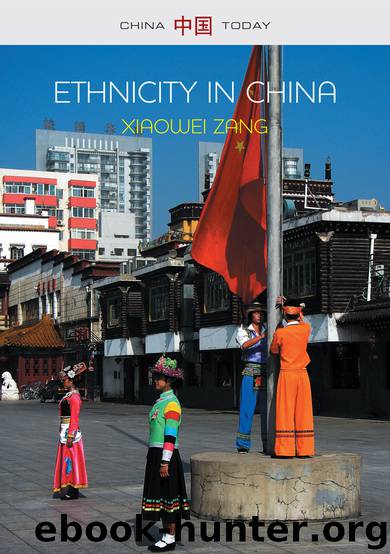Ethnicity in China: a Critical Introduction by Zang Xiaowei;

Author:Zang, Xiaowei;
Language: eng
Format: epub
ISBN: 9780745690452
Publisher: Polity Press
Published: 2015-03-17T16:00:00+00:00
Intra-Group Differences
Generally speaking, there are two major types of intra-group differences within each minority group in China. Firstly, members of each ethnic minority group may be differentiated from one another culturally and linguistically. More often than not, each official minority nationality group includes internally diverse populations as a result of the ethnic classification project of 1953. One example is Uyghur Muslims in Xinjiang. Exactly when a unified Uyghur nation was formed is a subject of debate. Rudelson (1997, p. 39) maintains that most Uyghurs were oriented towards their oases before 1949. Shichor (2005, p. 127) insists that Uyghur nationalism did not begin to take shape until the 1920s and 1930s. Gladney (2004a, p. 103) argues that ‘the people of the (Xinjiang) oases lacked any coherent sense of identity.’ In the early 1930s, Sheng Shicai, the Han warlord who ruled Xinjiang at that time, used ‘Uyghur’ to categorize Turkic residents in all oases following the recommendation of his Soviet advisors. According to Rudelson (1997), the immensity and harshness of the Tarim Basin continued to separate the oasis centres in Xinjiang from each other. The practice of oasis endogamy (marriage within the community) further perpetuated a strong local identity. He argues that oasis identities undermined hopes to develop a coherent Uyghur national identity (Rudelson 1997, pp. 116, 144; see also Schluessel 2007, p. 270). After 1949, ‘the CCP maintained the pre-existing KMT policy of labeling the disparate oasis-based Turkic Muslims as “Uyghurs”’ (Hess 2009, pp. 76, 83–4; Gladney 2004a, pp. 104–6, 108).
Another example is the Dai people, who are culturally and linguistically similar to the Thais of Thailand and the Shan of Myanmar. One aspect of this similarity is religious practice: they practise Theravāda Buddhism almost alone among China's peoples. However, they form several distinct cultural and linguistic groups. The two main languages of the Dai are Dai Lü and Dai Nüa; two other written languages used by the Dai are Tày Pong and Tai Dam (Mackerras 2005a). The Yao people similarly consist of several subgroups who speak different dialects and practise different religions including Buddhism, Taoism and Christianity. The Miao people include many distinct subgroups such as Hmong, Hmu and A Hmao, which differ from each other in architecture, costume, ritual and dialect. There are also internal differences in dialects and styles of farming among each Miao subgroup. For example, there are Black Hmong, White Hmong and Red Hmong among Hmong, who speak different dialects and engage in different cultural practices (Tapp 2002a, pp. 71–3, 75–6, 81; see also Deal and Hostetler 2006; Schein 2000; Tapp 2002b; 2002c). Before 1949, the subgroups of the so-called Zhuang people lived in different geographic areas, spoke different dialects, wore different costumes, and practised different rituals. They did not necessarily define their ethnic affiliation in terms of the broad Zhuang category (Kaup 2002, pp. 867, 869, 873). This vast intra-group difference takes place mainly because of the ethnic classification project discussed in chapter 1, as the broad nationality categories such as Hui, Yi or Miao were conveniently invented or used to cover internally diverse or unrelated populations.
Download
This site does not store any files on its server. We only index and link to content provided by other sites. Please contact the content providers to delete copyright contents if any and email us, we'll remove relevant links or contents immediately.
| Anthropology | Archaeology |
| Philosophy | Politics & Government |
| Social Sciences | Sociology |
| Women's Studies |
Nudge - Improving Decisions about Health, Wealth, and Happiness by Thaler Sunstein(7518)
iGen by Jean M. Twenge(5347)
The Fire Next Time by James Baldwin(5219)
Adulting by Kelly Williams Brown(4458)
The Hacking of the American Mind by Robert H. Lustig(4291)
The Sports Rules Book by Human Kinetics(4254)
The Ethical Slut by Janet W. Hardy(4158)
Captivate by Vanessa Van Edwards(3780)
Mummy Knew by Lisa James(3606)
In a Sunburned Country by Bill Bryson(3464)
The Worm at the Core by Sheldon Solomon(3413)
Ants Among Elephants by Sujatha Gidla(3390)
Suicide: A Study in Sociology by Emile Durkheim(2959)
The 48 laws of power by Robert Greene & Joost Elffers(2949)
The Slow Fix: Solve Problems, Work Smarter, and Live Better In a World Addicted to Speed by Carl Honore(2929)
Humans of New York by Brandon Stanton(2793)
The Tipping Point by Malcolm Gladwell(2674)
Handbook of Forensic Sociology and Psychology by Stephen J. Morewitz & Mark L. Goldstein(2647)
The Happy Hooker by Xaviera Hollander(2640)
